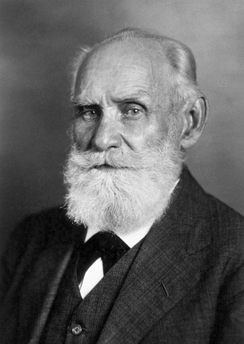| << Chapter < Page | Chapter >> Page > |
Does the name Ivan Pavlov ring a bell? Even if you are new to the study of psychology, chances are that you have heard of Pavlov and his famous dogs.
Pavlov (1849–1936), a Russian scientist, performed extensive research on dogs and is best known for his experiments in classical conditioning ( [link] ). As we discussed briefly in the previous section, classical conditioning is a process by which we learn to associate stimuli and, consequently, to anticipate events.

Pavlov came to his conclusions about how learning occurs completely by accident. Pavlov was a physiologist, not a psychologist. Physiologists study the life processes of organisms, from the molecular level to the level of cells, organ systems, and entire organisms. Pavlov’s area of interest was the digestive system (Hunt, 2007). In his studies with dogs, Pavlov surgically implanted tubes inside dogs’ cheeks to collect saliva. He then measured the amount of saliva produced in response to various foods. Over time, Pavlov (1927) observed that the dogs began to salivate not only at the taste of food, but also at the sight of food, at the sight of an empty food bowl, and even at the sound of the laboratory assistants' footsteps. Salivating to food in the mouth is reflexive, so no learning is involved. However, dogs don’t naturally salivate at the sight of an empty bowl or the sound of footsteps.
These unusual responses intrigued Pavlov, and he wondered what accounted for what he called the dogs' “psychic secretions” (Pavlov, 1927). To explore this phenomenon in an objective manner, Pavlov designed a series of carefully controlled experiments to see which stimuli would cause the dogs to salivate. He was able to train the dogs to salivate in response to stimuli that clearly had nothing to do with food, such as the sound of a bell, a light, and a touch on the leg. Through his experiments, Pavlov realized that an organism has two types of responses to its environment: (1) unconditioned (unlearned) responses, or reflexes, and (2) conditioned (learned) responses.
In Pavlov’s experiments, the dogs salivated each time meat powder was presented to them. The meat powder in this situation was an unconditioned stimulus (UCS) : a stimulus that elicits a reflexive response in an organism. The dogs’ salivation was an unconditioned response (UCR) : a natural (unlearned) reaction to a given stimulus. Before conditioning, think of the dogs’ stimulus and response like this:
In classical conditioning, a neutral stimulus is presented immediately before an unconditioned stimulus. Pavlov would sound a tone (like ringing a bell) and then give the dogs the meat powder ( [link] ). The tone was the neutral stimulus (NS) , which is a stimulus that does not naturally elicit a response. Prior to conditioning, the dogs did not salivate when they just heard the tone because the tone had no association for the dogs. Quite simply this pairing means:

Notification Switch
Would you like to follow the 'Psychology' conversation and receive update notifications?